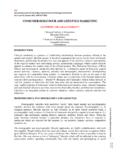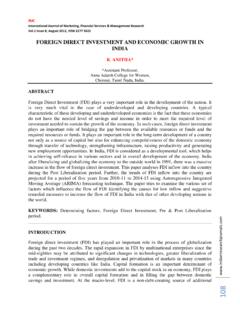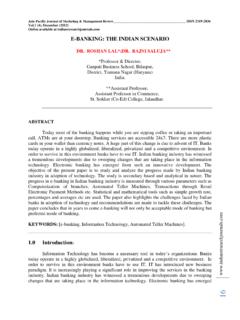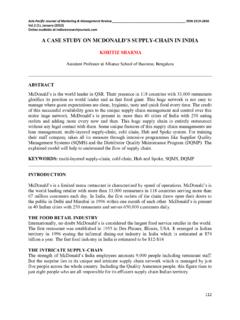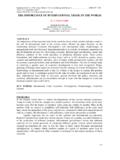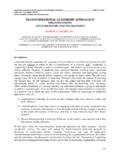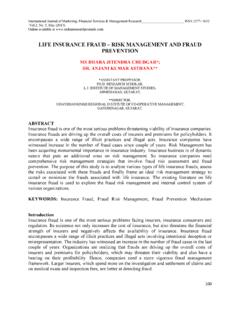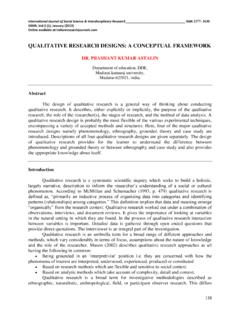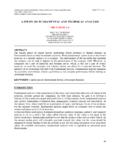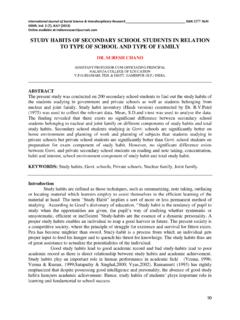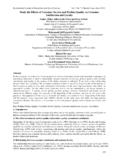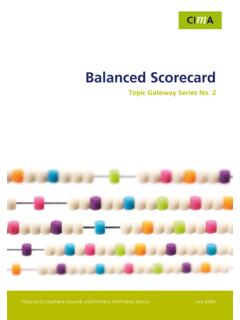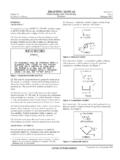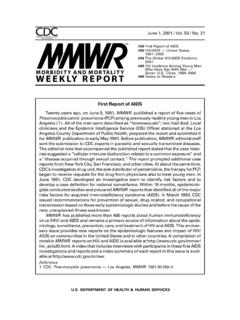Transcription of TOTAL QUALITY MANAGEMENT IN HIGHER EDUCATION …
1 International Journal of Social Science & Interdisciplinary Research_____ ISSN 2277 3630 IJSSIR, Vol. 2 (6), june (2013) Online available at 121 TOTAL QUALITY MANAGEMENT IN HIGHER EDUCATION INSTITUTIONS DR. T. SUDHA PROFESSOR AMJAD ALI KHAN COLLEGE OF BUSINESS ADMINISTRATION MOUNT PLEASANT, ROAD NO 3 BANJARA HILLS, HYDERABAD-34 _____ ABSTRACT The QUALITY of HIGHER EDUCATION is everybody s concern today. Various studies and commission reports at official level has recognized the same and given recommendations for its improvement. Government and other constitutional agencies are taking necessary measures. But these alone, will not serve the purpose unless institutions and faculty take proactive initiatives and measures. A challenge of foreign institutions entering the Indian HIGHER EDUCATION is going to pose the threat of even survival of poor performing institutions.
2 The advantages of TOTAL QUALITY MANAGEMENT have been valued by many companies around the world. Many organizations have achieved excellence and competitive lead by putting into practice TQM policy. Most of the principles of TQM can be implemented in the area of EDUCATION and training. This paper highlights the essence of TQM and explains how HIGHER EDUCATION institutions can improve the QUALITY by implementing TQM principles. KEYWORDS: HIGHER EDUCATION Institutes, TOTAL QUALITY MANAGEMENT , Product dimensions, Service Dimensions, QUALITY dimensions Introduction Academic institutions offering HIGHER EDUCATION in general and those offering professional EDUCATION in particular are undergoing a process of change similar to what business organizations have undergone a few decades ago when they were confronted by competition.
3 The speed of change is driven by multiple factors. Demands from industry, information-age mind set of the students, increased competition and the renewed quest among academic community are some of the factors driving this change. To ensure that HIGHER EDUCATION , particularly professional EDUCATION , is able to deal with market and technological changes coupled with global requirements, it is important for institutions offering HIGHER EDUCATION to use appropriate curricula, course materials and teaching methodologies that are not only up-to-date, but also effective from learner s point of view. The exponential growth of knowledge, exploding instructional technologies, enhanced access to practices of premier institutions, accessibility to knowledge, globalization of EDUCATION etc require educators and faculty members to continuously evaluate themselves and improve upon their effectiveness HIGHER EDUCATION HIGHER EDUCATION imparts in-depth knowledge and understanding so as to advance the students to new frontiers of knowledge in different walks of life (subject domains).
4 It develops the student International Journal of Social Science & Interdisciplinary Research_____ ISSN 2277 3630 IJSSIR, Vol. 2 (6), june (2013) Online available at 122 ability to question and seek truth and makes him/her competent to critique on contemporary issues. It broadens the intellectual powers of the individual within a narrow specialization, but also gives him/her a wider perspective of the world around. According to Ronald Barnett (1992) there are four predominant concepts of HIGHER EDUCATION . i) HIGHER EDUCATION as the production of qualified human resources: In this view, HIGHER EDUCATION is seen as a process in which students are counted as products absorbed in labour market. Thus, HIGHER EDUCATION becomes input to the growth and development of business and industry. ii) HIGHER EDUCATION as training for a research career: In this view, HIGHER EDUCATION is preparation for qualified scientists and researchers who would continuously develop the frontiers of knowledge.
5 QUALITY within this view point is more about research publications and transmission of academic rigour to do QUALITY research. iii) HIGHER EDUCATION as the efficient MANAGEMENT of teaching profession: Many strongly believe that teaching is the core of educational institutions. Thus, HIGHER EDUCATION institutions focus on efficient MANAGEMENT of teaching-learning provisions by improving the QUALITY of teaching, enabling a HIGHER completion rate among the students. iv) HIGHER EDUCATION as a matter of extending life chances: In this view, HIGHER EDUCATION is seen as an opportunity to participate in the development process of individual through a flexible, continuing EDUCATION mode. Interestingly, all these four concepts of HIGHER EDUCATION are not exclusive; rather they are integrated and give an overall picture of HIGHER EDUCATION . If we look at the activities of colleges and universities, we will realize that teaching, research and extension form the three main functions of HIGHER EDUCATION .
6 Role of HIGHER EDUCATION in the Society HIGHER EDUCATION is generally understood to cover teaching, research and extension. Scientific and technological advancement and economic growth of a country are as dependent on HIGHER EDUCATION as they are on the working class. Development of indigenous technologies and capabilities in agriculture, food security and other industrial areas are possible because of our world-class HIGHER EDUCATION infrastructure. HIGHER EDUCATION also provides opportunities for lifelong learning, allowing people to upgrade their knowledge and skills from time to time based on societal needs. The Kothari Commission (1966) listed the following roles of the universities ( HIGHER EDUCATION institutions in the modern society) To seek and cultivate new knowledge, to engage vigorously and fearlessly in the pursuit of truth, and to interpret old knowledge and beliefs in the light of new deeds and discoveries; To provide the right kind of leadership in all walks of life, to identify gifted youth and help them develop their potential full by cultivating physical fitness, developing the powers of the mind and cultivating right interests, attitudes and moral and intellectual values; International Journal of Social Science & Interdisciplinary Research_____ ISSN 2277 3630 IJSSIR, Vol.
7 2 (6), june (2013) Online available at 123 To provide the society with competent men and women trained in agriculture, arts, medicine, science and technology and various other professions, who will also be cultivated individuals, imbibed with a sense of social purpose; To strive to promote QUALITY and social justice, and to reduce social cultural differences through diffusion of EDUCATION ; and To foster in the teachers and students and through them in the society generally, the attitudes and values needed for developing the good life in individuals and society (GOI, 1966, p. 497-8) Defining QUALITY The British Standard Institution (BSI) defines QUALITY as the totality of features and characteristics of a product or service that bears on its ability to satisfy the stated or implied needs (BSI, 1991).
8 Green and Harvey (1993) identified five different approaches to defining QUALITY : In terms of exceptional (Exceeding high standards and passing required standards); In terms of consistency (exhibited through Zero defects and getting right the first time , making QUALITY a culture); As fitness for purpose (meaning the product or service meets the stated purpose, customer specifications and satisfaction) As value for money (through efficiency and effectiveness); and As transformative (in terms of qualitative change) These different notions of QUALITY have lead Reeves and Bedner (1994) to conclude the search for a universal definition of QUALITY and statement of law like relationship has been unsuccessful . According to Gummesson (1990) it might be useful to create an insight into the many dimensions that form a fuzzy entity referred to as QUALITY through social consensus rather than defining it.
9 Garvin (1998) classified the various definitions of QUALITY into five major groups: (1) Transcendent definitions: These definitions are subjective and personal. They are eternal but go beyond measurement and logical description (2) Product-based definitions: QUALITY is seen as measurable variable. The basis for measurement is objective of the product. (3) User-based definitions: QUALITY is a means for customer satisfaction. This makes these definitions individual and partly subjective. (4) Manufacturing-based definitions: QUALITY is seen as conformance to requirements and specifications. International Journal of Social Science & Interdisciplinary Research_____ ISSN 2277 3630 IJSSIR, Vol. 2 (6), june (2013) Online available at 124 (5) Value-based definitions: These definitions define QUALITY in relation to costs. QUALITY is seen as providing good value for costs ( Largosen et al, 2004) QUALITY has a few central ideas around which the whole concept revolves: QUALITY as absolute, QUALITY as relative, QUALITY as a process, and QUALITY as culture.
10 When we consider QUALITY as absolute, it is given and considered as the highest possible standard. The Egyptian Pyramids and the Taj Mahal are works of high standards and QUALITY . In product terms, they are attached with high brand values, status and positional advantages. Educational institutions such as Oxford, Cambridge and Stanford in the west have this absolute QUALITY standard, though in the case of EDUCATION it might still be perceptual. QUALITY as relative suggests that the QUALITY of a product or service can be described in relative terms. QUALITY here can be measured in terms of certain specifications. According to Mukhopadhya (2005) the adherence to product specification is actually, the minimum condition for QUALITY but not the sufficient condition . The sufficient condition is customer satisfaction and beyond . Why HIGHER EDUCATION Institutions should worry about QUALITY As teachers, principals, heads of the department and policy makers in EDUCATION we should worry about QUALITY of teaching, programmes, and institution because of the reasons (1) Competition: We are entering a new regime, where competition among educational institutions for students and funds will be highly significant.
